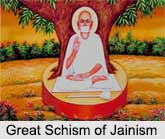 Great Schism of Jainism is the most important event in the history of Jainism. This took place in around 300 B.C. after the death of Lord Mahavira. As a result of which the Jains have been divided into two separate bodies.
Great Schism of Jainism is the most important event in the history of Jainism. This took place in around 300 B.C. after the death of Lord Mahavira. As a result of which the Jains have been divided into two separate bodies.
According to the history of Jainism, there were 8 schisms out of which the 8th schism was important as it ultimately split the Jain community into two distinct sects of the Digambaras and the Swetambaras. The great schism took place in order to prove the antiquity of their particular sects and over the question of the more or less rigorous maintenance of the ancient rules of order. Both the sects have put forward their own theories regarding their origin of the other sect. These schisms contributed to the rise of sects and sub-sects in the Jain religion.
History of the Great Schisms of Jainism
In the 3rd century BC, famous Jain saint, Sruta Kevali Bhadrabahu predicted a long and severe famine in the kingdom of Magadha (present Bihar). In order to avoid the adverse condition of the famine, he along with 12000 monks migrated from Pataliputra, the capital of Magadha to Shravanbelgoda (in modern Karnataka) in South India. Chandragupta Maurya (322-298 BC) who was a King and was very much devoted to Bhadrabahu, joined Bhadrabahu"s entourage as a monk disciple and stayed with him at Shravanbelgoda. Chandragupta was a devout ascetic disciple of Bhadrabahu in about 297 BC, after practicing penance died according to the strict Jain rite of "Sallekhana" on the same hill at Shravanbelgoda. This Bhadrabahu-Chandragupta tradition is supported by a large number of epigraphic and literary evidence of a very reliable nature.
When the ascetics of Bhadrabahu Sangha returned to Pataliputra after the end of 12 yrs periods of famine, they were surprised as two major changes had taken place during their absence, among the ascetics of Magadha under the leadership of Sthulabhadra.
•Firstly, the rule of nudity was relaxed and the monks were allowed to wear a piece of white cloth (Ardhaphalakas).
•Secondly, scared books were collected and edited at a council of Pataliputra specially convened for the purpose.
As a result of which the monks who had returned did not accept the two introduced things by the followers of Acharya Sthulabhadra, namely, the relaxation of the rule of nudity and the recession of the scared tenets, and proclaimed themselves as true Jains. Eventually, the Jain community was split into two distinct sects namely;
1. The Digambaras
2. The Swetambaras.
In the beginning when the schism materialized, the difference between the two sects was not acute and did not take form of a dogmatic and doctrinaire rigidity. It is significant to note that the practice of nudity was strictly observed by Tirthankara Mahavira. The ascetic members of his Sangha were later on found impracticable and discarded generally by some sections of the ascetic order of the Jains. It is clear from the facts that the Jains, by and larger agreed that nakedness was the highest ideal as it is characteristic of Jina. Accordingly, they had the nude images of Tirthankaras found in different parts of India.




















